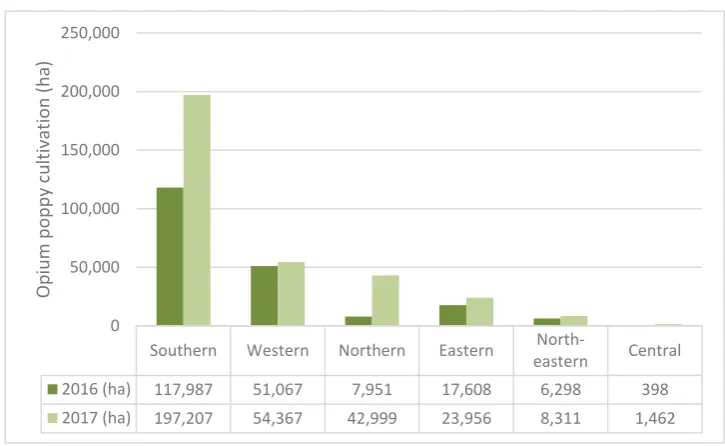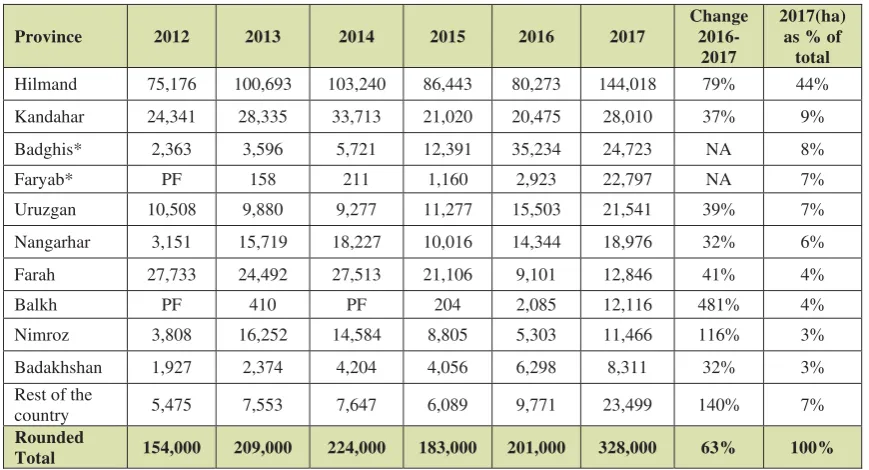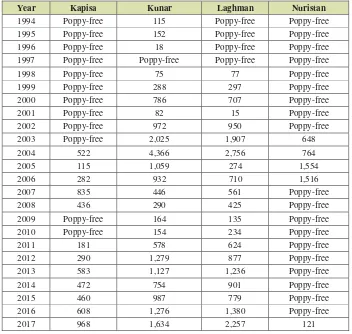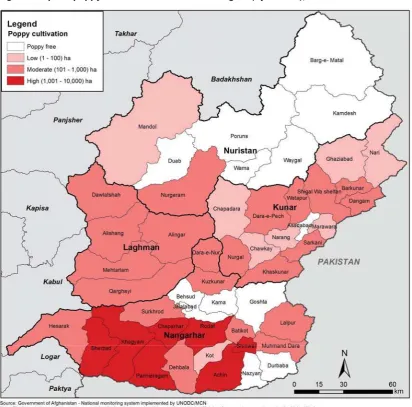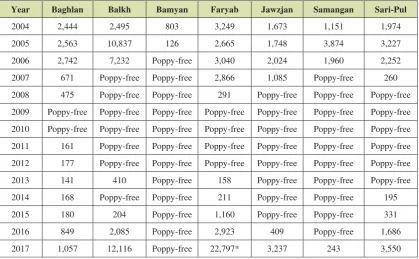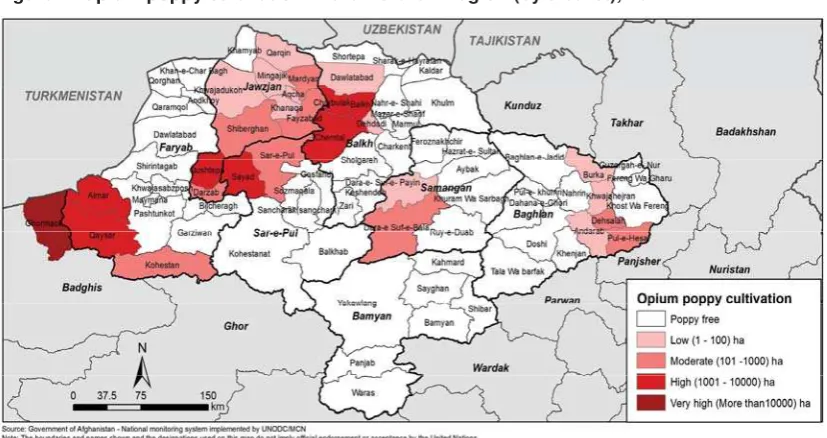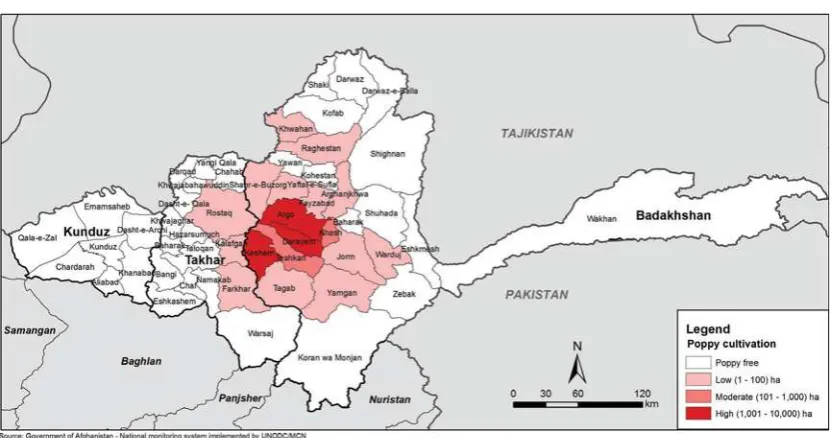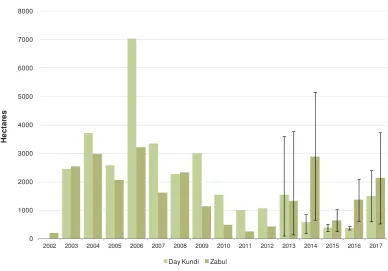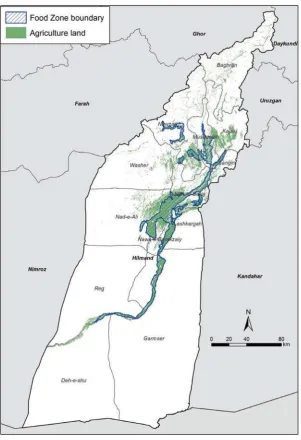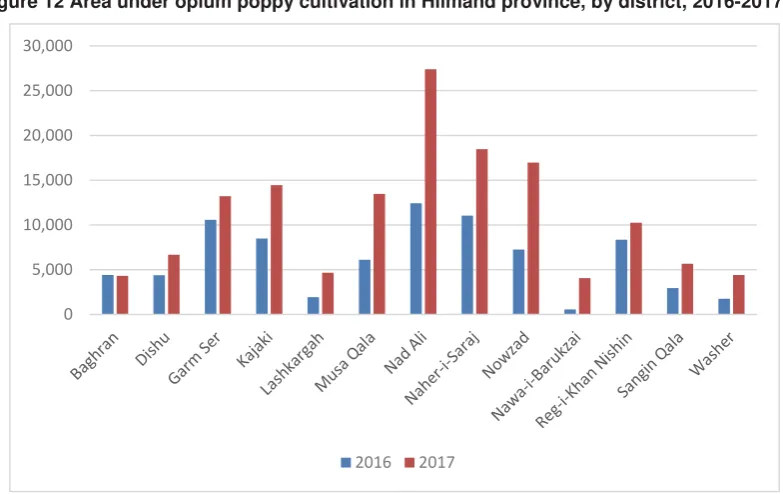NOVEMBER 2017
The following organizations and individuals contributed to the implementation of the Afghanistan & Remote sensing analyst), Ahmad Shabir Tayeeb (GIS & Remote Sensing Analyst), Sayed Shahenshah Sadat (Quality Control and Digit Specialist), Ahmad Mustafa Safi (Database Analysis
Remote Sensing Analysts: Ahmad Jawid Ghiasee and Sayed Mehdi Sadat. Ziaulhaq Sidiqi (GIS
Associate), Marzieh Noori (Project Associate)
Survey Coordinators: Abdul Basir Basiret (Eastern Region), Mohammad Jawad Salari (Western
Region), Rahimullah Omar (Central Region), Mazullah (Northern Region), Sadir (Northeastern region).
United Nations Office on Drugs and Crime (Vienna)
Jean-Luc Lemahieu (Director, Division for Policy Analysis and Public Affairs), Angela Me (Chief, Research and Trend Analysis Branch), Anja Korenblik (Chief, Programme Development and Management Unit), Coen Bussink (Team leader, Illicit Crop Monitoring Programme), Jaqueline Garcia-Yi (Research Officer), Lorenzo Vita (GIS & Remote Sensing Expert), Irmgard Zeiler (Statistician).
The implementation of the survey would not have been possible without the dedicated work of the field surveyors, who often faced difficult security conditions.
Contents
LIST OF FIGURES ... 3
LIST OF TABLES ... 4
KEY FINDINGS ... 5
FACT SHEET AFGHANISTAN OPIUM SURVEY 2017 ... 8
1 INTRODUCTION ... 9
2 OPIUM POPPY CULTIVATION ... 13
2.1 NATIONAL AND REGIONAL OPIUM POPPY CULTIVATION TRENDS ... 13
2.2 PROVINCIAL BREAKDOWN ... 18
3 ERADICATION ... 34
3.1 POPPY ERADICATION INCREASED BY 111% IN 2017 ... 34
3.2 QUALITY CONTROL OF REPORTED ERADICATION WITH SATELLITE IMAGES 36 4 POTENTIAL OPIUM YIELD AND PRODUCTION ... 39
4.1 POTENTIAL OPIUM YIELD AND PRODUCTION INCREASED IN 2017 ... 39
4.2 POTENTIAL HEROIN PRODUCTION IN AFGHANISTAN ... 42
5 OPIUM PRICES AND FARM-GATE VALUE OF OPIUM ... 44
5.1 OPIUM PRICES ... 44
5.2 FARM-GATE VALUE OF OPIUM PRODUCTION ... 46
6 METHODOLOGY ... 48
6.1 ESTIMATION OF AREA UNDER OPIUM POPPY CULTIVATION ... 48
6.2 SATELLITE IMAGE INTERPRETATION ... 53
6.3 VERIFICATION OF GOVERNOR-LED ERADICATION (GLE) ... 58
6.4 OPIUM YIELD AND PRODUCTION ... 58
6.5 HEROIN PRODUCTION ... 60
6.6 AVERAGE FARM-GATE PRICE AND FARM-GATE VALUE OF OPIUM PRODUCTION ... 63
ANNEX I: INDICATIVE DISTRICT LEVEL ESTIMATES OF OPIUM POPPY CULTIVATION, 2005-2017 (HECTARES) ... 64
Figure 1: Opium poppy cultivation in Afghanistan, 1994-2017 (Hectares) ... 13
Figure 2: Opium poppy cultivation in Afghanistan, by region 2016-2017 (Hectares) ... 14
Figure 3: Number of provinces by opium poppy cultivation trends, 2006-2017 ... 15
Figure 4: Opium poppy cultivation in the Central region (by district), 2017... 19
Figure 5: Opium poppy cultivation in Nangarhar province, 1994-2017 (Hectares) ... 20
Figure 6: Opium poppy cultivation in the Eastern region (by district), 2017 ... 22
Figure 7: Opium poppy cultivation in the Northern region (by district), 2017 ... 24
Figure 8: Opium poppy cultivation in Badakhshan province, 1994-2017 (Hectares) ... 25
Figure 9: Opium poppy cultivation in the North-eastern region (by district), 2017 ... 25
Figure 10: Opium poppy cultivation in Day-Kundi and Zabul provinces, 2002-2017... 26
Figure 11: Hilmand Food Zone, 2011 ... 28
Figure 12 Area under opium poppy cultivation in Hilmand province, by district, 2016-2017 ... 29
Figure 13: Opium poppy cultivation increase in Hilmand province, 2016-2017 ... 30
Figure 14: Opium poppy cultivation in Hilmand, Kandahar and Uruzgan provinces, 2004-2017 (Hectares) ... 31
Figure 15 Opium poppy cultivation in the Southern region (by district), 2017 ... 31
Figure 16: Opium poppy cultivation in Farah and Nimroz provinces, 2004-2017 (Hectares) ... 33
Figure 17 Opium poppy cultivation in the Western region (by district), 2017... 33
Figure 18: Area of opium poppy eradication, by different methods, 2016-2017 (Percentage of total) ... 35
Figure 19: Area of opium poppy eradication, per month, 2016-2017 (Percentage of total) ... 36
Figure 20: Percentage of poppy eradication in each field in Badakhshan province, by number of fields, 2017 ... 37
Figure 21: Quality check of partially eradicated fields using satellite imagery in Badakhshan province in 2017 ... 38
Figure 22: Potential opium production in Afghanistan, 1994-2017 (mt) ... 42
Figure 23 Dry opium prices collected from traders in Nangarhar and Kandahar provinces (US$/Kg), March 1997-July 2017 ... 45
Figure 24: Farm-gate prices of dry opium at harvest time weighted by production and annual opium production, 1999-2017 (tons; US dollars per kilogram) ... 46
Figure 25: Farm-gate value of opium production in Afghanistan, 2008-2017 (Million US dollars) ... 47
Figure 26: Spectral reflectance of opium poppy and other crops ... 54
Figure 27: Image classification methodology for estimating opium poppy cultivation area ... 54
Figure 28: Use of geo-referenced ground photos for image interpretation ... 56
Table 1: Regional distribution of opium poppy cultivation, 2016-2017 (Hectares) ... 14
Table 2: Main opium-poppy-cultivating provinces in Afghanistan, 2012-2017 (Hectares) ... 16
Table 3: Opium poppy cultivation (2013-2017) and eradication (2016-2017) in Afghanistan (Hectares) ... 17
Table 4: Opium poppy cultivation and eradication in the Central region, 2015-2017 (Hectares) . 18 Table 5: Opium poppy cultivation and eradication in the Eastern region, 2015-2017 (Hectares) 20 Table 6: Opium poppy cultivation in Laghman, Kunar, Nuristan and Kapisa provinces, 1994-2017 (Hectares) ... 21
Table 7: Opium poppy cultivation and eradication in the Northern region, 2014-2017 (Hectares) ... 23
Table 8: Opium poppy cultivation in the Northern region, 2004-2017 (Hectares) ... 23
Table 9: Opium poppy cultivation and eradication in the North-eastern region, 2015-2017 (Hectares) ... 24
Table 10: Opium poppy cultivation and eradication in the Southern region, 2015-2017 (Hectares) ... 26
Table 11: Poppy cultivation inside and outside the former Hilmand “Food Zone” (after eradication), 2013-2017 ... 27
Table 12: Opium poppy cultivation and eradication in the Western region, 2015-2017 (Hectares) ... 32
Table 13: Governor-led eradication, by province, 2017 ... 34
Table 14: Governor-led eradication, 2016-2017 ... 35
Table 15: Opium poppy eradication and cultivation in Afghanistan, 2011-2017 (Hectares) ... 35
Table 16: Start and end dates of Governor-led eradication, 2017 ... 36
Table 17: Opium yield, by region, 2016-2017 (Kilograms per hectare) ... 39
Table 18: Potential opium production, by region, 2016-2017 (mt) ... 40
Table 19: Opium production in Afghanistan 2014-2017, by province (mt) ... 41
Table 20: Potential opium production, by region, with ranges, 2017 (mt) ... 42
Table 21: Potential heroin production from Afghan opium (mt), 2017 ... 43
Table 22: Regional farm-gate prices of dry opium at harvest time, reported by farmers through the price-monitoring system, 2016-2017 (US dollars per kilogram) ... 44
Table 23: Dry opium prices reported by opium traders, by region, August 2016-August 2017 (US dollars per kilogram) ... 44
Table 24: Area estimation method, by province, 2017 ... 48
Table 25: Sample size and agricultural land and sampling ratio, by province, 2017 ... 50
Table 26: Area estimates of sample provinces with 95% confidence interval, 2016 (Hectares) .... 52
Table 27: Regional opium yield values with 95% confidence intervals, 2016 (Kilograms per hectare) ... 59
Key
Findings
Area under opium poppy cultivation increased by 63% since 2016, reaching a new record high
The total area under opium poppy cultivation in Afghanistan was estimated at 328,000 hectares in 2017, a 63% increase or 127,000 hectares more compared to the previous year. This level of opium poppy cultivation is a new record high and exceeds the formerly highest value recorded in 2014 (224,000 hectares) by 104,000 hectares or 46%.
Strong increases were observed in almost all major poppy cultivating provinces. In Hilmand province alone, cultivation increased by 63,700 hectares (+79%) which accounted for about half of the total national increase. Strong increases were observed also in Balkh (+10,000 hectares or almost five times more than in 2016), Kandahar (+7,500 hectares or +37%), Nimroz (+6,200 hectares or +116%), and Uruzgan (+6,000 hectares or +39%).
The majority (60%) of cultivation took place in the South of the country. The Western region accounted for 17% of total cultivation, the Northern region for 13% and the Eastern region for 7%. The remaining regions (North-eastern and Central) together accounted for 3%.
Hilmand remained the country’s major opium poppy cultivating province, followed by Kandahar, Badghis, Faryab,1 Uruzgan,2 Nangarhar, Farah, Balkh, Nimroz and Badakhshan.
Opium poppy cultivation expanded to new regions and intensified where there was cultivation before
In 2017, the number of poppy-free provinces in Afghanistan decreased from 13 to 10. The number of provinces affected by opium poppy cultivation increased from 21 to 24. Ghazni, Samangan and Nuristan provinces lost their poppy-free status. Ghazni had been poppy-free for more than two decades (since 1995), Samangan and Nuristan for almost 10 years (since 2007).
Starting in 2014, the Northern region experienced a rapid expansion of opium poppy cultivation. In 2014, a total of 574 hectares was cultivated in three out of seven provinces (Baghlan, Faryab and Sari-Pul); in 2017, only one province remained poppy-free (Bamyan) and some 43,000 hectares were cultivated in the other six provinces.3
Cultivation in Balkh, which was poppy-free until 2014, expanded from 204 hectares in 2015 to 12,100 hectares in 2017. In Jawzjan, which was poppy-free between 2008 and 2015, cultivation increased from 409 hectares in 2016 to 3,200 hectares in 2017. In Sari-Pul (last time poppy-free in 2013), cultivation expanded from 195 hectares in 2014 to 3,600 hectares in 2017.
Opium poppy cultivation intensified in the main opium-poppy cultivating provinces by holding a more significant share of the available agricultural land. In Hilmand, a third of the arable land was dedicated to opium poppy in 2017, whereas only 20% was under cultivation in 2016. Less drastically, but still significant increases in density could be observed in Uruzgan and Nangarhar where a fourth of the arable land was under opium poppy cultivation in 2017 compared to 19% in Uruzgan and 16% in Nangarhar in 2016.
Total eradication of opium poppy increased by 395 hectares but remained very low
In 2017, 750 hectares of opium poppy were eradicated in 14 provinces (355 hectares in 7 provinces in 2016). During the 2017 eradication campaign, six lives were lost and eight persons were injured. In 2016, eight lives were lost and seven persons were injured.
1 Including Ghormach district, a district formerly part of Badghis, but since 2017 under the administration of the Governor of
Potential opium yield and production increased in 2017
Potential opium production was estimated at 9,000 tons in 2017, an increase of 87% from its 2016 level (4,800 tons). The increase in production is mainly a result of an increase in area under opium poppy cultivation, while an increase in opium yield per hectare also contributed.
In 2017, the average opium yield amounted to 27.3 kilograms per hectare, which was 15% higher than in 2016. Yields increased in the Southern region by 19% (from 22.0 kilograms per hectare in 2016 to 26.2 kilograms per hectare in 2017), in the North-eastern region by 14% (from 31.2 to 35.4 kilograms per hectare) and in the Eastern region by 8% (from 32.4 to 34.9 kilograms per hectare). In the Central and Northern regions, yields decreased by 5% and 6% respectively and remained stable in the Western region.
Accounting for 57% of national production, the Southern region continued to produce the vast majority of opium in Afghanistan. With 16% of national production, the Northern region was the second most important opium-producing region in 2017, followed by the Western region (13%) and Eastern region (9%).
In response to the increased supply of opium, 2017 prices at harvest time decreased in all regions (between -7% in the Western region and -50% in the North-eastern region) of Afghanistan except in the Southern region where prices only dropped in the months after the harvest.
At almost US$ 1.4 billion (1.2 – 1.5 billion), equivalent to roughly 7% of Afghanistan’s estimated GDP,4 the farm-gate value of opium production increased by 55% in 2017 as compared to past year.5
Reasons for the increase
There is no single reason for the massive 2017 increase in opium poppy cultivation in Afghanistan. The multiple drivers are complex and geographically diverse, as many elements continue to influence farmers’ decisions regarding opium poppy cultivation.
Rule of law-related challenges, such as political instability, lack of government control and security, as well as corruption, have been found to be main drivers of illicit cultivation. also impact farmers’ decisions, for example scarce employment opportunities, lack of quality education and limited access to markets and financial services continue to contribute to the vulnerability of farmers towards opium poppy cultivation.
A combination of events may have exacerbated some of these elements and may have led to the large increase in 2017. The shift in strategy by the Afghan government - focusing its efforts against anti-government elements (AGE) in densely populated areas - may have made the rural population more vulnerable to the influence of AGE. This may have subsequently contributed to the strong increase in the area under opium poppy cultivation. Political instability and increased insecurity particularly affected the Northern region, where opium poppy cultivation expanded drastically in the last couple of years. Generally, the weaker engagement of the international aid community may also have reduced the socio-economic development opportunities in rural areas.
In Hilmand province, additional factors may have played a role. In 2017, reports from the field indicate that more cheap labour for harvesting might have become available. In combination with increasing yields in 2016, this could have motivated many farmers to take up or expand opium poppy cultivation. The opium harvest requires a large number of skilled labourers, who often come from other provinces of Afghanistan and even from neighbouring countries. In past years, there have been reports of a lack of workers, caused by the on-going fights within Hilmand, which may have led farmers to restrict their investments in opium poppy cultivation to avoid the risk of unharvested fields.
profitable even under unfavourable natural conditions. Solar panels for irrigation seem to have replaced diesel pumps in many areas. These panels require a sizable initial investment, but have lower running costs than diesel-powered pumps and thus can turn desert areas into highly productive arable land at a relatively low cost. The nation-wide high opium farm-gate prices of 2016 might have facilitated some of these investments.
Future challenges
The 2017 record levels of opium poppy cultivation in Afghanistan create multiple challenges for the country, its neighbours and the many other countries that are transit for or destination of Afghan opiates. The significant levels of opium poppy cultivation and illicit trafficking of opiates will probably further fuel instability, insurgency and increase funding to terrorist groups in Afghanistan. More high quality, low cost heroin will reach consumer markets across the world, with increased consumption and related harms as a likely consequence.
Addressing the opiate problem in Afghanistan remains a shared responsibility. Only a small share of the revenues generated by the cultivation and trafficking of Afghan opiates reaches Afghan drug trafficking groups. Many more billions of dollars are made from trafficking opiates into major consumer markets, mainly in Europe and Asia. Moreover, the transformation of opium into heroin is likely to bring increased trafficking of precursor substances. Tons of precursor chemicals will potentially be diverted from licit international markets and smuggled into Afghanistan to supply manufacturers of heroin.
In Afghanistan, one of the least-developed countries worldwide, the impact of the illicit drug cultivation and production on economic, environmental and social development, continues to be multifaceted. The large increase in opium production will reinforce the negative consequences of the already existing large-scale production of opiates. The expanding illicit economy, which in many provinces has permeated rural societies and made many communities dependent on the income from opium poppy, will further constrain the development of the licit economy and potentially further fuel corruption. The increased levels of opium poppy cultivation also have the potential to exacerbate existing environmental damage caused by overexploitation of the land for opium. The increased availability of opium and heroin in the country might further raise the social and economic costs associated with the consumption of opiates for drug users, their families, and for society in general.
Fact
Sheet
Afghanistan
Opium
Survey
2017
2016 Change from 2016 2017
Net opium poppy cultivation (after eradication)6
201,000 ha
(181,000 - 221,000) +63%
328,000 ha (301,000 - 355,000)
Number of poppy-free
provinces7 13 -3 10
Number of provinces affected by opium poppy cultivation
21 +3 24
Eradication 355 ha +111% 750 ha
Average opium yield
(weighted by cultivation) 23.8 kg/ha +15% 27.3 kg/ha
Potential production of opium
4,800 mt
(4,000 - 5,600) +87%
9,000 mt (8,000 -10,000)
Average farm-gate price (weighted by production) of fresh opium at harvest time
US$ 152/kg -14% US$ 131/kg
Average farm-gate price (weighted by production) of dry opium at harvest time
US$ 187/kg -17% US$ 155/kg
Total farm gate value of
1
Introduction
The Afghanistan Opium Survey is implemented annually by the Ministry of Counter Narcotics (MCN) of Afghanistan in collaboration with the United Nations Office on Drugs and Crime (UNODC). The survey team collects and analyses information on the location and extent of opium poppy cultivation, potential opium production and the socio-economic situation in rural areas. Since 2005, MCN and UNODC have also been involved in the verification of opium eradication conducted by provincial governors and poppy-eradication forces. The results provide a detailed picture of the outcome of the current year’s opium season and, together with data from previous years, enable the identification of medium- and long-term trends in the evolution of the illicit drug problem. This information is essential for planning, implementing and monitoring the impact of measures required for tackling a problem that has serious implications for Afghanistan and the international community.
The opium survey is implemented within the technical framework of the UNODC Illicit Crop Monitoring Programme (ICMP). The objective of ICMP is to assist the international community in monitoring the extent and evolution of illicit crops, an objective that was reiterated in the plan of action adopted by the United Nations (the 53rd session of the Commission on Narcotic Drugs in March 2009) and in a recent outcome document from the United Nations General Assembly Special Session on the World Drug Problem8. Under ICMP, monitoring activities currently supported by UNODC also exist in other countries affected by illicit crop cultivation: in Asia, Myanmar; in Latin America, the Plurinational State of Bolivia, Colombia, Mexico and Peru; in Africa, Nigeria.
The Afghanistan Opium Survey 2017 was implemented under project AFG/F98, “Monitoring of Opium Production in Afghanistan”, with financial contributions from the Governments of Japan and the United States of America.
2
Opium
Poppy
Cultivation
2.1
National
and
regional
opium
poppy
cultivation
trends
The total area under opium poppy cultivation in Afghanistan was estimated at 328,000 hectares in 2017, a 63% increase or 127,000 hectares more compared to the previous year. This level of opium poppy cultivation is a new record high since the beginning of the systematic monitoring and exceeds the formerly highest value of 2014 (224,000 hectares) by 104,000 hectares or 46%.
Strong increases were observed in almost all major poppy cultivating provinces. In Hilmand province alone, cultivation increased by 63,745 hectares (+79%) which accounted for about half of the total national increase. Strong increases were observed also in Balkh (+10,031 hectares or almost five times more than in 2016), Kandarhar (+7,535 hectares or +37%), Nimroz (+6,163 hectares or +116%), and Uruzgan (+6,038 hectares or +39%).
The regional distribution of opium poppy cultivation shows that the majority (60%) of cultivation took place in the South of the country. The Western region accounted for 17% of total cultivation; the Northern region for 13% and the Eastern region for 7%. The remaining regions (North-Eastern and Central) together accounted for 3%.
Hilmand remained the country’s major opium poppy cultivating province at 144,018 hectares, followed by Kandahar (28,010 hectares), Badghis (24,723 hectares), Faryab (22,797 hectares),9 and Uruzgan (21,541 hectares).10
In 2017, the number of poppy-free provinces in Afghanistan decreased from 13 to 10. Opium poppy cultivation in Samangan, in the Northern region, was estimated at 243 hectares and lost its poppy-free status, which it gained 2007. Ghazni and Nuristan also lost their poppy-free status which they had kept since 1995 and 2007, respectively.
Figure 1: Opium poppy cultivation in Afghanistan, 1994-2017 (Hectares)
Sources: MCN/UNODC opium surveys 1994-2017. The vertical lines represent the upper and lower bounds of the 95% confidence interval.
1994 1995 1996 1997 1998 1999 2000 2001 2002 2003 2004 2005 2006 2007 2008 2009 2010 2011 2012 2013 2014 2015 2016 2017
H
e
ctar
Table 1: Regional distribution of opium poppy cultivation, 2016-2017 (Hectares)
*In 2017, the provincial boundaries of Badghis (Western region) and Faryab (Northern region) were changed. Ghormach district, formerly part of Badghis province and a major opium poppy cultivating district, came in 2017 under the administration of the Governor of Faryab province. The changes in opium poppy cultivation in these two regions are affected by this change.
Figure 2: Opium poppy cultivation in Afghanistan, by region 2016-2017 (Hectares)
In 2017, the provincial boundaries of Badghis (Western region) and Faryab (Northern region) were changed. Ghormach district, formerly part of Badghis province and a major opium poppy cultivating district, came in 2017 under the administration of the Governor of Faryab province. The changes in opium poppy cultivation in these two regions are affected by this change.
In the Eastern region, the increase of opium poppy cultivation was mainly driven by the strong increase in Nangarhar (+4,632 hectares or +32%). Strong relative increases albeit at lower levels were also observed in Laghman (+877 hectares or +64%), Kapisa (+360 hectares or +59%) and Kunar (+358 hectares or +28%). Nuristan province lost its poppy-free status with 121 hectares of opium poppy cultivation (Nuristan was poppy-free since 2007). A total of 261 hectares of opium poppy were eradicated in Kapisa, Kunar, Laghman and Nangarhar provinces in 2017.
In the North-Eastern region, Badakhshan saw a significant increase of 32% in opium poppy cultivation from 6,298 hectares to 8,311 hectares. Eradication in Badakhshan province was 269
22,797 hectares in 2017 which can be mostly attributed to a change in provincial boundaries: the major opium poppy cultivating district Ghormach, formerly part of Badghis province in the Western region came in 2017 under the administration of the Governor of Faryab province. Samangan province (243 hectares) lost its poppy-free status, which it had since 2007. In the past three years no eradication was carried out in the Northern region with an exception of Sari-Pul (33 hectares in 2015 and 55 hectares in 2016) and Balkh (25 hectares in 2017).
In the Southern region, opium poppy cultivation increased in all provinces: Day-Kundi (+1,134 hectares or +303%), Hilmand (+63,745 hectares or +79%), Zabul (+768 hectares or +56%), Uruzgan (+6,038 hectares or +39%) and Kandahar (+7,535 hectares or 37%). Hilmand remained in 2017 the country’s main opium-poppy-cultivating province, accounting for 44% of total opium poppy cultivation. There was no eradication carried out in the Southern region with exception of Kandahar, where 48 hectares of opium poppy were eradicated in 2017.
The Western region remained in 2017 the second most important opium poppy cultivating region in the country. The two main poppy-cultivating provinces, Farah and Nimroz, saw significant increases, 41% (+3,745 hectares) and 116% (+6,163 hectares), respectively. Opium poppy cultivation also increased by 431% or 896 hectares in Hirat province in 2017. Levels of opium poppy cultivation in 2017 in Badghis province cannot be compared to 2016, because Ghormach district, a major opium poppy cultivating district, came under the administration of the Governor of Faryab province (Northern region) in 2017.
Table 2: Main opium-poppy-cultivating provinces in Afghanistan, 2012-2017 (Hectares)
Province 2012 2013 2014 2015 2016 2017
Change
2016-2017
2017(ha) as % of
total
Hilmand 75,176 100,693 103,240 86,443 80,273 144,018 79% 44%
Kandahar 24,341 28,335 33,713 21,020 20,475 28,010 37% 9%
Badghis* 2,363 3,596 5,721 12,391 35,234 24,723 NA 8%
Faryab* PF 158 211 1,160 2,923 22,797 NA 7%
Uruzgan 10,508 9,880 9,277 11,277 15,503 21,541 39% 7%
Nangarhar 3,151 15,719 18,227 10,016 14,344 18,976 32% 6%
Farah 27,733 24,492 27,513 21,106 9,101 12,846 41% 4%
Balkh PF 410 PF 204 2,085 12,116 481% 4%
Nimroz 3,808 16,252 14,584 8,805 5,303 11,466 116% 3%
Badakhshan 1,927 2,374 4,204 4,056 6,298 8,311 32% 3% Rest of the
country 5,475 7,553 7,647 6,089 9,771 23,499 140% 7%
Rounded
Total 154,000 209,000 224,000 183,000 201,000 328,000 63% 100%
Table 3: Opium poppy cultivation (2013-2017) and eradication (2016-2017) in Afghanistan (Hectares)
2.2
Provincial
Breakdown
2.2.1 Centralregion
(Ghazni, Kabul, Khost, Logar, Paktika, Paktya, Panjshir, Parwan, Wardak)
In 2017, opium poppy cultivation in the Central region was almost four times higher than in 2016, with the total area under cultivation increasing from 398 hectares in 2016 to 1,462 hectares in 2017.
Ghazni province with 1,027 hectares under opium poppy cultivation lost its poppy-free status which it held for more than 20 years since 1995. Opium poppy was mainly cultivated in Ajrestan district where the security situation is extremely poor.
In Kabul province opium poppy cultivation was limited to the Uzbeen valley of Surobi district, where security was extremely poor. A total of 27 hectares of opium poppy were eradicated in 2017 in this province.
Table 4: Opium poppy cultivation and eradication in the Central region, 2015-2017 (Hectares)
PROVINCE Cultivation
2015 (ha)
Cultivation 2016 (ha)
Cultivation 2017 (ha)
Change 2016-2017 (%)
Eradication in 2016 (ha)
Eradication in 2017(ha)
Ghazni Poppy-free Poppy-free 1,027 NA 0 0
Kabul 321 398 435 9% 0 27
Khost Poppy-free Poppy-free Poppy-free - 0 0
Logar Poppy-free Poppy-free Poppy-free - 0 0
Paktika Poppy-free Poppy-free Poppy-free - 0 0
Paktya Poppy-free Poppy-free Poppy-free - 0 0
Panjshir Poppy-free Poppy-free Poppy-free - 0 0
Parwan Poppy-free Poppy-free Poppy-free - 0 0
Wardak Poppy-free Poppy-free Poppy-free - 0 0
Central Region 321 398 1,462 267% 0 27
Figure 4: Opium poppy cultivation in the Central region (by district), 2017
2.2.1 Easternregion
(Kapisa, Kunar, Laghman, Nangarhar, Nuristan)
The Eastern region experienced a 36% increase in opium poppy cultivation from 17,608 hectares in 2016 to 23,956 hectares in 2017. In 2017, 261 hectares were eradicated.
Table 5: Opium poppy cultivation and eradication in the Eastern region, 2015-2017
A province is defined as poppy-free when it is estimated to have less than 100 hectares of opium poppy cultivation.
In 2017, opium poppy cultivation in Nangarhar increased by 32% from 14,344 hectares in 2016 to 18,976 hectares in all main opium poppy cultivating districts: Khugyani, Chaprahar, Batikot, Darah-i- Noor, Hesark, Lalpoor, Mohmand Dara, Rodat, Shinwari and Sherzad.
Figure 5: Opium poppy cultivation in Nangarhar province, 1994-2017 (Hectares)
The vertical lines represent the upper and lower bounds of the 95% confidence interval.
In Laghman province, opium poppy cultivation increased by 64% from 1,380 hectares in 2016 to 2,257 hectares in 2017. At the district level, increases were observed in all opium poppy cultivating districts (Alingar, Alishang, Dowlat Shah, Mehterlam and Qarghayee).
In Kunar province, opium poppy cultivation increased by 28% from 1,276 hectares in 2016 to 1,634 hectares in 2017. The main opium poppy cultivating districts were Sarkani, Noor Gal, Shigal Wa Sheltan, Watapoor and Dangam.
Opium poppy cultivation in Kapisa province increased by 59%, from 608 hectares in 2016 to 968 hectares in 2017. Tagab and Alasai were the main opium-poppy-cultivating districts.
1994 1995 1996 1997 1998 1999 2000 2001 2002 2003 2004 2005 2006 2007 2008 2009 2010 2011 2012 2013 2014 2015 2016 2017
H
ectar
Table 6: Opium poppy cultivation in Laghman, Kunar, Nuristan and Kapisa provinces, 1994-2017 (Hectares)
Year Kapisa Kunar Laghman Nuristan
1994 Poppy-free 115 Poppy-free Poppy-free
1995 Poppy-free 152 Poppy-free Poppy-free
1996 Poppy-free 18 Poppy-free Poppy-free
1997 Poppy-free Poppy-free Poppy-free Poppy-free
1998 Poppy-free 75 77 Poppy-free
1999 Poppy-free 288 297 Poppy-free
2000 Poppy-free 786 707 Poppy-free
2001 Poppy-free 82 15 Poppy-free
2002 Poppy-free 972 950 Poppy-free
2003 Poppy-free 2,025 1,907 648
2004 522 4,366 2,756 764
2005 115 1,059 274 1,554
2006 282 932 710 1,516
2007 835 446 561 Poppy-free
2008 436 290 425 Poppy-free
2009 Poppy-free 164 135 Poppy-free
2010 Poppy-free 154 234 Poppy-free
2011 181 578 624 Poppy-free
2012 290 1,279 877 Poppy-free
2013 583 1,127 1,236 Poppy-free
2014 472 754 901 Poppy-free
2015 460 987 779 Poppy-free
2016 608 1,276 1,380 Poppy-free
Figure 6: Opium poppy cultivation in the Eastern region (by district), 2017
2.2.1 Northernregion
(Baghlan, Balkh, Bamyan, Faryab, Jawzjan, Samangan, Sari-Pul)
In Baghlan province, opium poppy cultivation increased from 849 hectares in 2016 to 1,057
hectares in 2017. The main opium-poppy-cultivating districts were Deh Salah, Pul-i-Hisar, Andrab and Khwajah Hijran (Jalgah).
In 2017, opium poppy cultivation in Balkh increased almost sixfold from 2,085 hectares to 12,116 hectares. Until 2014, Balkh was poppy-free; it lost this status in 2015 with 204 hectares of opium poppy cultivation. In 2017 opium poppy was mainly cultivated in Chimtal, Chahar Bolak and Balkh districts.
Bamyan has been poppy-free since 2007 and remained so in 2017.
Sari-Pul province was poppy-free from 2008 to 2013. The province lost its poppy-free status in 2014 with 195 hectares of opium poppy cultivation. In 2015, opium poppy cultivation increased to 331 hectares, in 2016 to 1,686 hectares and in 2017 to 3,550 hectares. The main opium cultivating districts were Sayyad and Sari-Pul provincial center.
Jawzjan province was poppy-free from 2008 to 2015, but lost its poppy-free status in 2016 with 409 hectares of opium poppy cultivation. In 2017, levels of cultivation further increased to 3,237 hectares, which was almost eight times more than in 2016.
Table 7: Opium poppy cultivation and eradication in the Northern region, 2014-2017 (Hectares)
PROVINCE Cultivation 2014 (ha) Cultivation 2015 (ha) Cultivation 2016 (ha) Cultivation 2017 (ha)
Change
Samangan Poppy-free Poppy-free Poppy-free 243 NA 0 0
Sari-Pul 195 331 1,686 3,550 +111% 55 0
Northern
Region 574 1,875 7,951 42,999 +441% 55 25
A province is defined as poppy-free when it is estimated to have less than 100 hectares of opium poppy cultivation. Ghormach district, formerly part of Badghis province and a major opium poppy cultivating district, came in 2017 under the administration of the Governor of Faryab province. The changes in opium poppy cultivation in Faryab and thus of the region are affected by this change.
Table 8: Opium poppy cultivation in the Northern region, 2004-2017 (Hectares)
Year Baghlan Balkh Bamyan Faryab Jawzjan Samangan Sari-Pul
2004 2,444 2,495 803 3,249 1,673 1,151 1,974
2005 2,563 10,837 126 2,665 1,748 3,874 3,227
2006 2,742 7,232 Poppy-free 3,040 2,024 1,960 2,252
2007 671 Poppy-free Poppy-free 2,866 1,085 Poppy-free 260
2008 475 Poppy-free Poppy-free 291 Poppy-free Poppy-free Poppy-free
2009 Poppy-free Poppy-free Poppy-free Poppy-free Poppy-free Poppy-free Poppy-free
2010 Poppy-free Poppy-free Poppy-free Poppy-free Poppy-free Poppy-free Poppy-free
2011 161 Poppy-free Poppy-free Poppy-free Poppy-free Poppy-free Poppy-free
2012 177 Poppy-free Poppy-free Poppy-free Poppy-free Poppy-free Poppy-free
2013 141 410 Poppy-free 158 Poppy-free Poppy-free Poppy-free
2014 168 Poppy-free Poppy-free 211 Poppy-free Poppy-free 195
2015 180 204 Poppy-free 1,160 Poppy-free Poppy-free 331
Figure 7: Opium poppy cultivation in the Northern region (by district), 2017
2.2.1 NorthǦeasternregion
(Badakhshan, Kunduz and Takhar)
The only opium poppy cultivating province in the region was Badakhshan province as the two other provinces, Kunduz and Takhar were poppy-free.
Opium poppy cultivation in Badakhshan increased by 32% from 6,298 in 2016 to 8,311 hectares in 2017 and was mostly confined to rain-fed areas cultivated in spring, mainly in Argo, Darayim and Kishim districts. A total of 269 hectares of opium poppy were eradicated in Badakhshan province in 2017.
Kunduz province has been poppy-free since 2007 and is well known for growing a wide range of licit crops, from fruit and vegetables to cotton. An insignificant amount of cultivation was observed in this province in recent years. It remained under 100 hectares in 2017, the threshold for obtaining the poppy-free status.
Takhar province was poppy-free since 2008, and it maintained its poppy-free status in 2017. However, small amounts of cultivation below the threshold of 100 hectares were observed in this province. A total of 15 hectares were eradicated in 2017.
Table 9: Opium poppy cultivation and eradication in the North-eastern region, 2015-2017 (Hectares)
PROVINCE Cultivation
2015 (ha)
Cultivation 2016 (ha)
Cultivation 2017 (ha)
Change 2016-2017
(%)
Eradication in 2016 (ha)
Eradication in 2017 (ha)
Badakhshan 4,056 6,298 8,311 32% 270 269
Kunduz Poppy-free Poppy-free Poppy-free - 0 0
Takhar Poppy-free Poppy-free Poppy-free - 21 15
North-eastern
Region 4,056 6,298 8,311 32% 291 284
Figure 8: Opium poppy cultivation in Badakhshan province, 1994-2017 (Hectares)
The high-low lines represent the upper and lower bounds of the 95% confidence interval.
Figure 9: Opium poppy cultivation in the North-eastern region (by district), 2017
1994 1995 1996 1997 1998 1999 2000 2001 2002 2003 2004 2005 2006 2007 2008 2009 2010 2011 2012 2013 2014 2015 2016 2017
H
e
ct
ar
2.2.1 Southernregion
A province is defined as poppy-free when it is estimated to have less than 100 hectares of opium poppy cultivation.
Figure 10: Opium poppy cultivation in Day-Kundi and Zabul provinces, 2002-2017
A province is defined as poppy-free when it is estimated to have less than 100 hectares of opium poppy cultivation. The vertical lines represent the upper and lower bounds of the 95% confidence interval.
Hilmand province experienced the significant increase of 79% in opium poppy cultivation and remained Afghanistan’s single largest opium-poppy-cultivating province in 2017. Hilmand accounted for 44% of the total area under opium poppy cultivation in Afghanistan and for almost half of the total national increase between 2016 and 2017. In 2017, no Governor-led eradication was carried out (like in 2016) in this province.
At the district level, opium poppy cultivation levels were highest in Nad Ali, Naher-i-Saraj, Nawzad, Kajaki, Musa Qala, Garmser, Regi-i-Khan Nishin, Dishu, Sangin Qala, Lashkargah,
2002 2003 2004 2005 2006 2007 2008 2009 2010 2011 2012 2013 2014 2015 2016 2017
H
ect
ar
es
estimates of the area under opium poppy cultivation within and outside of the former “Food Zone” area for monitoring purposes.
Inside the former Food Zone, opium poppy cultivation increased by 90% from 34,760 hectares in 2016 to 66,181 hectares in 2017, outside of the former Food Zone it increased by 71% (from 45,513 hectares in 2016 to 77,837 hectares). Overall, 33% of the agricultural land was under opium poppy cultivation in Hilmand, 31% inside of the area of the former Food Zone, 35% outside of the area of the former Food Zone.
Table 11: Poppy cultivation inside and outside the former Hilmand “Food Zone” (after eradication), 2013-2017
Cultivation 2013 (ha)
Cultivation 2014 (ha)
Cultivation 2015 (ha)
Cultivation 2016 (ha)
Cultivation 2017 (ha)
Change 2016 -2017
(%)
Inside the
food zone 36,244 41,089 31,216 34,760 66,181 90% Outside the
food zone 64,449 62,151 55,227 45,513 77,837 71%
Total 100,693 103,240 86,443 80,273 144,018 79%
The Food Zone estimates refer to an area in ten districts of Hilmand (the “Food Zone” as of 2011), where farmers were provided with fertilizers, certified wheat seeds and high-value horticulture seeds in the poppy planting seasons for the 2009-2012 harvests. See e.g. Afghanistan Opium Survey 2009.
In Kandahar province, opium poppy cultivation increased by 37% from 20,475 hectares in 2016 to 28,010 hectares in 2017. The main opium poppy cultivation districts were Maiwand, Zhire, Nesh, Spin Boldak and Panjwayee.
In Uruzgan province opium poppy cultivation increased by 39% from 15,503 hectares in 2016 to 21,541 hectares in 2017. Tirin, Kot, Dihrawud and Shahidi, Hassas were the main opium poppy-cultivating districts.
Figure 12 Area under opium poppy cultivation in Hilmand province, by district, 2016-2017
0 5,000 10,000 15,000 20,000 25,000 30,000
g
Poppy fields 2016
Poppy fields 2017
Figure 13: Opium poppy cultivation increase in Hilmand province, 2016-2017
Lashkargah Musaqalah
Figure 14: Opium poppy cultivation in Hilmand, Kandahar and Uruzgan provinces, 2004-2017 (Hectares)
The high-low lines represent the upper and lower bounds of the 95% confidence interval.
2.2.1 Westernregion (Badghis, Farah, Ghor, Hirat, Nimroz)
Opium poppy cultivation in Farah province increased by 41% from 9,101 hectares in 2016 to 12,846 hectares in 2017. The main opium-poppy-cultivating districts in Farah, were Bala Buluk, Bakwah, Khak-i-Safed, Pusht-Rod and Gulistan where security was very poor (see district details in the Annex I).
In 2017, opium poppy cultivation in Ghor, poppy-free in 2011, increased more than 3 times when compared to 2016: from 1,222 hectares to 4,228 hectares. The main opium cultivating districts were Ghaghcharan, Pasaband and Taywara.
In Hirat province, the level of opium poppy cultivation increased more than 5 times when
compared to 2016, from 208 hectares to 1,104 hectares. The main opium poppy cultivating districts in Hirat province were Shindand and Kushk (Rabat-i-Sangi), where security was very poor.
In 2017, the level of opium poppy cultivation in Nimroz province (11,466 hectares) more than doubled since 2016 (5,303 hectares). The main poppy cultivating districts were Khash-Rod and Chahar Burjak.
The levels of opium poppy cultivation in 2016 and 2017 in Badghis province are not comparable due to changes in the administrative boundaries. Ghormach district, formerly part of Badghis province and a major opium poppy cultivating district, came in 2017 under the administration of the Governor of Faryab province.
In 2017, a total 106 hectares of Governor-led eradication was carried out in Badghis (55 hectares), Ghor (14 hectares), Hirat (23 hectares) and Nimroz (14 hectares).
Table 12: Opium poppy cultivation and eradication in the Western region, 2015-2017 (Hectares)
PROVINCE Cultivation 2015 (ha) Cultivation 2016 (ha) Cultivation 2017 (ha)
Change
Figure 16: Opium poppy cultivation in Farah and Nimroz provinces, 2004-2017 (Hectares)
The high-low lines represent the upper and lower bounds of the 95% confidence interval.
Figure 17 Opium poppy cultivation in the Western region (by district), 2017 0
5,000 10,000 15,000 20,000 25,000 30,000 35,000 40,000 45,000
2004 2005 2006 2007 2008 2009 2010 2011 2012 2013 2014 2015 2016 2017
Hect
ares
3
Eradication
3.1
Poppy
eradication
increased
by
111%
in
2017
A total of 750 hectares of verified poppy eradication was carried out by the provincial Governors in 2017. This represented an increase of 111% from 2016 when 355 hectares of Governor-led eradication (GLE) was verified by MCN/UNODC.
In 2017, MCN/UNODC field surveyors verified the eradication of 7,271 fields in 317 villages in 14 provinces. In 2016 MCN/UNODC verifiers visited 201 villages (7,922 poppy fields) in 7 provinces.
Quality control of eradication verification was carried out using satellite data in Badakhshan, Balkh, Badghis, Kandahar, Kabul, Kapisa, Hirat and Nangarhar provinces. Final figures for eradication in these provinces were confirmed after checking with high-resolution satellite imagery supported by GPS tracking files, and photographs from the ground. For the provinces of Takhar, Laghman, Nimroz, Ghor, Jawzjan and Kunar, the quality checks were based on a detailed check of the survey forms, area measurement calculations and on field photographs.
Major observations on the 2016 and 2017 eradication campaigns:
x Total eradication of opium poppy increased by 111% from 355 hectares in 2016 to 750 hectares in 2017.
x In 2017, less security incidents occurred than in 2016: in 2017, 6 lives were lost and 8 persons were injured; in 2016, 8 lives were lost and 7 persons were injured.
x Eradication took place in 14 provinces in 2017 (7 provinces in 2016): Badakhshan, Balkh, Badghis, Ghor, Hirat, Jawzjan, Kabul, Kapisa, Kandahar, Nimroz, Kunar, Laghman, Nangarhar and Takhar.
x Eradication started on 7 March in Nimroz, on 16 May in Badakhshan province and concluded on 20 July in Badakhshan.
x The largest amount of poppy eradication took place in Badakhshan province (269 hectares; almost the same amount as in 2016), followed by Nangarhar province (204 hectares).
x Since 2016, there has not been any eradication in Hilmand, which is the province with the highest levels of opium poppy cultivation in Afghanistan.
x Quality of eradication was checked by using satellite data in Badakhshan province. The quality of eradication in Badakhshan province was very poor with partially eradicated fields and at similar levels as last year.
Table 13: Governor-led eradication, by province, 2017
Province Verified eradication (ha) No. of eradicated fields No. of villages eradication
Table 14: Governor-led eradication, 2016-2017
Province Verified eradication (ha) 2016 Verified eradication (ha) 2017
Badakhshan 270 269
Badghis 0 55
Balkh 0 25
Ghor 0 14
Hirat 0 23
Jawzjan 0 0.3
Kabul 0 27
Kandahar 4 48
Kapisa 0 3
Kunar 0 31
Laghman 3 23
Nangarhar 1 204
Nimroz 1 14
Sari-Pul 55 0
Takhar 21 15
Total 355 750
Table 15: Opium poppy eradication and cultivation in Afghanistan, 2011-2017 (Hectares)
Year 2011 2012 2013 2014 2015 2016 2017
Number of provinces where eradication was carried out
18 18 18 17 12 7 14
Governor-led Eradication (GLE), (ha)
3,810 9,672 7,348 2,692 0 355 750
Cultivation (ha) * 131,000 154,000 209,000 224,000 183,000 201,000 328,000
% poppy in insecure provinces of South and West
95% 95% 89% 89% 90% 84% 77%
Poppy-free
provinces 17 17 15 15 14 13 10
* Net opium poppy cultivation after eradication.
Figure 19: Area of opium poppy eradication, per month, 2016-2017 (Percentage of total)
3.2
Quality
control
of
reported
eradication
with
satellite
images
As in previous years, in 2017, MCN/UNODC procured high-resolution satellite images based on field coordinates recorded by verifiers in eradicated poppy fields to validate the authenticity of reports and generate more accurate area figures by on-screen digitization of the eradicated fields.
Since 2013, surveyors have generated a GPS track around eradicated fields that provides both the location and shape of the fields. These tracks have helped verification of eradicated fields with satellite imagery.
In 2017, satellite images of eradicated fields were interpreted and compared with the figures reported from field and corrected for over-reporting or under-reporting.
In Badakhshan province, eradication reported by verifiers were checked with satellite imagery and the final eradication figures were corrected to 269 hectares. Similar to previous years, the quality of eradication (measured in terms of the area of a field that was actually eradicated) was reported from field and confirmed with satellite imagery. Out of 4,231 eradicated fields, only 46 percent of the fields could be considered to be fully eradicated (more than 80% of the field area eradicated). In 1,309 poppy fields only 20% and in 1,912 poppy fields more than 20% but less than 30% of the field area was eradicated.
Figure 21: Quality check of partially eradicated fields using satellite imagery in Badakhshan province in 2017
4
Potential
opium
yield
and
production
4.1
Potential
opium
yield
and
production
increased
in
2017
12In 2017, estimated potential opium production in Afghanistan amounted to 9,000 tons (8,000-10,000 tons), which was an increase of 87% from its 2016 level (4,800 tons). The average opium yield amounted to 27.3 kilograms per hectare in 2017, which was 15% more than in 2016 (23.8 kilograms per hectare).
The increase in potential opium production in 2017 is mainly explained by the larger area under opium poppy cultivation but higher opium yields per hectare also contributed to this increase. The largest relative increase in opium yield occurred in the Southern region, where yield increased by 19% from 22.0 kg/ha in 2016 to 26.2 kg/ha in 2017. In the Eastern and North-eastern regions, yields increased by 8% and 14%, respectively. The increase of yield in the Southern region, where 60% of the total area under opium poppy cultivation in Afghanistan took place, had a significant impact on the national potential opium production.
Table 17: Opium yield, by region, 2016-201713
(Kilograms per hectare)
REGION 2016 average
yield (kg/ha)
2017 average
yield (kg/ha) % Change
Central 46.1 43.8 -5%
Eastern 32.4 34.9 +8%
North-eastern 31.2 35.4 +14%
Northern 35.0 32.8 -6%
Southern 22.0 26.2 +19%
Western 22.3 22.3 0%
Weighted national
average 23.8 27.3 +15%
There are some limitations in the yield estimates since the yield survey was not implemented in all main cultivating provinces for security reasons. For the provinces not covered, the regional average was used. This year the yield surveys were extended to Badghis province in addition to the provinces covered last year.
Table 18: Potential opium production, by region, 2016-2017 (mt)
Region Production
2016 (tons)
Production 2017 (tons)
Change 2016-2017
(%)
2017 production as
% of total
Central 18 64 +256% 0.7%
Eastern 571 837 +47% 9%
North-eastern 196 294 +50% 3%
Northern* 278 1,408 +406% 16%
Southern 2,591 5,158 +99% 57%
Western* 1,139 1,210 +6% 13%
Total (rounded) 4,800 9,000 +87% 100%
Table 19: Opium production in Afghanistan 2014-2017, by province (mt)
Province Production 2014 (mt) Production 2015 (mt) Production 2016 (mt) Production 2017 (mt)
Change
Figure 22: Potential opium production in Afghanistan, 1994-2017 (mt)
Sources: MCN/UNODC opium surveys, 1994-2017. The vertical lines represent the upper and lower bounds of the confidence interval of the estimates. Figures refer to oven-dry opium. Production figures for 2006 to 2009 have been revised in 2012; see MCN/UNODC Afghanistan opium survey 2012.
*In 2017, the provincial boundaries of Badghis (Western region) and Faryab (Northern region) were changed. Ghormach district, formerly part of Badghis province and a major opium poppy cultivating district, came in 2017 under the administration of the Governor of Faryab province. The changes in opium production in these two regions are affected by this change.
4.2
Potential
heroin
production
in
Afghanistan
All the opium produced in Afghanistan each year is either exported as raw opium or in the form of heroin/morphine, consumed domestically in various forms, seized, stored for later use or lost (for example, due to mold, disposal to avoid seizures, etc.).
Estimating the amount of heroin that one year’s opium production can yield requires knowledge on a set of the critical components:
x the share of raw opium that is converted to heroin (for the domestic market or for export)
3,
1994 1995 1996 1997 1998 1999 2000 2001 2002 2003 2004 2005 2006 2007 2008 2009 2010 2011 2012 2013 2014 2015 2016 2017
To
There is a clear understanding of the amount of opium produced. However, the other factors related to the convertion ratio opium/heroin and the purities of these substances are much less clear as only secondary data can be used as a proxy. For example, the purity of the heroin seized is often not known. Likewise, the purity of heroin consumed domestically may differ substantially from the purity of heroin destined for export. Furthermore, little is known about when and where the conversion of morphine to heroin takes place.
In 2014, MCN/UNODC produced a revised estimate of the amount of raw opium needed to produce one kilogram of heroin/morphine since new data on the morphine content of Afghan opium gave reason to do so.15 However, apart from morphine content, the other factors related to the opium-to-heroin conversion chain are not well researched. Therefore the updated heroin conversion ratio provided only an indication of the actual average amount of opium needed to produce one kilogram of heroin. The situation has not changed since 2014 as no new studies on the conversion process were carried out.
New information has become available on the possible purity of heroin produced in Afghanistan. Recent data points towards higher purities than the previously assumed 51% reported by Turkey,16 with Italy and Lebanon reporting purities of 70% for heroin of wholesale quality in 2015; and Switzerland reporting 62% in the same year. The purity assumption of purity of export quality is relevant for both the estimated shares of the opium production that are converted to heroin and for the amount of heroin produced within Afghanistan.
In the following, a range of different purity assumptions is used, 50% to 70%. MCN/UNODC are working towards a better understanding of the amounts and the quality of heroin produced within Afghanistan and will provide a detailed discussion of all relevant factors in the upcoming report “Afghanistan opium survey 2017 – socio-economic analysis”.
Potentially, all opium produced in Afghanistan could be converted into morphine and heroin. In reality, however, a sizable proportion of opium is trafficked and consumed in the region in its raw form. Using information from 2014-2016 on the distribution of opium, morphine and heroin seizures in Afghanistan and neighboring countries, and using the 50% to 70% purity range of heroin of export quality, an estimate was made of the amount of the production of heroin with export quality versus the amount of unprocessed opium (see table 21). This analysis suggests that between 47% and 55% of all opium produced in Afghanistan is converted into heroin of export quality or morphine and the remainder is left unprocessed. It has to be noted, that the massive increase in opium supply may have an impact on this ratio, which can only be seen in seizure data of the coming years. More details on the estimation of heroin production in Afghanistan can be found in the methodology section.
A ratio of 18.5:1 (17.5:1 – 19.6:1) is used for converting opium to pure heroin base. For converting opium to 50% pure heroin, 9.2 kilograms (8.7 to 9.8 kilograms) of opium are assumed to be needed; for converting opium to 70% pure heroin, 12.9 kilograms (12.2 to 13.7 kilograms) of opium are assumed to be needed. For a detailed discussion of the heroin conversion ratio see the methodology section and Afghanistan opium survey report 2014 – cultivation and production.
15 The morphine content of opium harvested in Afghanistan has decreased since 2005, which was the reason for updating the
5
Opium
prices
and
farm
Ǧ
gate
value
of
opium
5.1
Opium
prices
Opium prices at the farm-gate present strong seasonal fluctuations and can vary substantially in reaction to the supply of opium on the market. In 2017, the average regional farm-gate prices at harvest time decreased in all regions of Afghanistan with exception of the Southern region, where they remained stable and started to decrease only in the months after the harvest. In the Southern region, opium was harvested earlier than in the rest of the country (May), so opium prices at the time of harvest did not yet strongly react to the increased supply of opium in the market. In the North and North-eastern regions, on the other hand, harvest takes place only in July, until when the supply from the South was already on the market, causing prices to decrease. The remaing regions are ‘in-between’ and thus showing different levels of price reactions.
Table 22: Regional farm-gate prices of dry opium at harvest time, reported by farmers through the price-monitoring system, 2016-2017 (US dollars per kilogram)
By August 2017, the average regional price of dry opium had substantially decreased in all regions, when compared to the previous year, which is an indication of the strong market reaction to the increased supply. Figure 22 shows how quickly and strongly the prices declined.
Table 23: Dry opium prices reported by opium traders, by region, August 2016-August 2017 (US dollars per kilogram) Western (Badghis, Farah, Ghor, Hirat, Nimroz) 267 228 -15% North-eastern (Badakhshan, Kunduz, Takhar) 132 64 -52% Northern (Baghlan, Balkh, Faryab, Jawzjan,
Samangan, Sari-Pul) 138 87 -37%
MCN/UNODC has been monitoring opium prices in selected provinces of Afghanistan on a monthly basis since 1994 (18 provinces as of September 2011) and has been calculating average farm-gate prices annually based on prices at harvest time weighted by regional production. Figure 24 shows that the average farm-gate price follows the laws of demand and supply: during years of high production (e.g. 2006 to 2008) the average price decreased, whereas following a supply shortage (for example the Taliban ban opium in 2001) the average price strongly increased.
Figure 24: Farm-gate prices of dry opium at harvest time weighted by production and annual opium production, 1999-2017 (tons; US dollars per kilogram)
5.2
Farm
Ǧ
gate
value
of
opium
production
Amounting to US$ 1,39 billion (US$ 1,23-1,55 billion), the estimated farm-gate value of opium production in 2017 increased by 58% from its 2016 level. The increase in farm-gate value was mainly due to the 87% increase in opium production.
Figure 25: Farm-gate value of opium production in Afghanistan, 2008-2017 (Million US dollars)
566
251 605
1,407
717 945
853 572
898
1,389
200 400 600 800 1,000 1,200 1,400 1,600 1,800
2008 2009 2010 2011 2012 2013 2014 2015 2016 2017
US$ (million)
6
Methodology
This chapter covers various methodological aspects regarding survey design and estimation procedure.
6.1
Estimation
of
area
under
opium
poppy
cultivation
Remote sensing methodologies have been used by UNODC since 2002 to monitor the extent of opium poppy cultivation in Afghanistan. Changes in the location of opium poppy cultivation and the increased security difficulties involved in accessing the area of interest require continuous improvements of the survey designs applied.
A sampling approach is used to cover those provinces where most of the poppy is found, whereas a targeted approach is used in provinces with a low level of opium poppy cultivation. “Targeted approach” means that a certain area of a province is fully covered by satellite imagery. Provinces without indication for opium poppy cultivation are covered by the village survey only.
From 2015, new and better satellite technology allowed for a major change in the study design: the size of the grid cells used for acquiring satellite imagery has been reduced from 10 x 10 km images to 5 x 5 km images. This change affected only provinces where a sampling approach was used; all other provinces were not affected by this change.
In 2017, out of 34 provinces in Afghanistan, 15 were sampled and 13 were targeted. The remaining 6 provinces were considered to be poppy-free based on information from the field. These provinces were not covered by the remote sensing survey, but were covered by the village survey.
In all provinces where a sampling approach was used in both 2016 and 2017, the same sampling locations were used, which ensured high levels of comparability.
Due to the more wide-spread cultivation activities in Jawjzan, Faryab and Laghman the approach was changed from a target approach in 2016 to a sampling approach in 2017. It cannot be excluded that this may have influenced the results, as some of the poppy might have been missed in 2016. Badghis province was re-sampled because of the change in provincial boundaries (Ghormach district).
Table 24: Area estimation method, by province, 2017
Region Targeted approach Sampling approach Village survey only
Central Ghazni, Kabul, Parwan, Logar Khost, Paktya, Panjshir, Wardak, Paktika
Eastern Kapisa, Nuristan Kunar, Nangarhar,
In Faryab, Almar, Ghormach and Qaysar districts were covered by a sampling approach, in the remaning districts a targeted approach was used.
6.1.1 Studydesign
6.1.1.1 Samplingframe
The sampling frame was established by extracting the area of land potentially available for opium poppy cultivation in 15 provinces. This area was divided into regular 5 km by 5 km grids, which constituted the sampling frame. The final sampling frame, from which the satellite images were randomly selected, consisted of 6,498 cells. In the case of images that cut across provincial boundaries, only the part falling into a particular province was considered to be in that province.
The area available for agriculture in the sampling frame covers irrigated and rain-fed land. The total area in the 15 provinces was 31,061 km2, which is equivalent to 38% of all potential agricultural land in Afghanistan. Potential land refers to all land available for cultivation and also includes land that is currently fallow.
Cells containing less than 0.25 km2 of potential agricultural land were excluded from the sampling frame in order to reduce the likelihood of choosing cells with very little arable land. In total, the exclusions represented less than 1% of the total potential agricultural land.
6.1.1.2 Samplesizedetermination
The total number of images to be selected in the sampled provinces was determined in 2015 with the goal to increase accuracy of the estimates and to save cost when compared to previous years.
The accuracy of area estimates depends on the proportion of land covered by satellite imagery and even more so on the number of images than can be acquired. With opium poppy cultivation being concentrated in hot spots and thus unevenly distributed across the agricultural land, information from a large, contiguous piece of land has less value than geographically evenly distributed, smaller pieces information. Costs associated with satellite imagery depends mainly on the total area covered (and not on the number of images). By using 5 x 5 km instead of 10 x 10 km images, at same costs four times the number of images can be acquired. Further details on the sample size determination methodology can be found in Opium Survey, December 2015, page 42.
6.1.1.3 Samplesizeallocation
The available number n of images has been distributed to provinces h according to a so-called power allocation, which uses agricultural area as size measure. For provincial sample size nh,
݊ൌ ݊ ܺ ܥܸ
σுୀଵܺܥܸ
where CVhis the coefficient of variation of area under poppy cultivation in province h and Xh land available for agriculture in province h. This approach ensures that sample size depends on both the variability of poppy and the size of the province measured by agricultural land. After an empirical assessment, the smoothing parameter q, 0q1, was set to 0.2. In addition, a mininum of 20 samples per provinces was set, which took effect in Day-Kundi and Kunar. This yielded the following sample size allocation
Table 25: Sample size and agricultural land and sampling ratio, by province, 2017
The same image locations were used in 2017 as in 2016 for 10 out of the 15 sampled provinces. The census approach in Ghor, Laghman, Jawzjan, Faryab provinces in 2016 were changed to sample approach this year. Badghis was resampled due to administrative boundary changes.
MCN/UNODC undertook an extensive simulation study which compared various sampling designs and estimation methods in order to determine the best (most accurate with a given number of samples) design for a certain situation.
Case studies were undertaken for Hilmand and Kandahar province. The sampling desings considered have been used in the past by MCN/UNODC:
x simple random sampling,
x probability proportional to size sampling (PPS), using agricultural area as a size measure,
x stratified random sampling using compact geostrata of equal size as strata,
x systematic random sampling.
Two estimation methods have been compared: a ratio estimator using agricultural area as auxiliary variable and the Horvitz-Thompson estimator.
The study concluded that for the two cases considered
x PPS performed best, and
x The ratio estimator is to be preferred for simple random sampling, systematic random sampling, and stratified random sampling. For PPS, it does not yield any improvements in accuracy.
